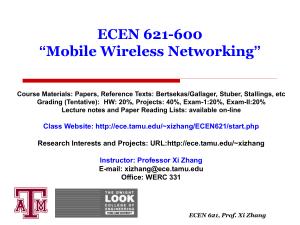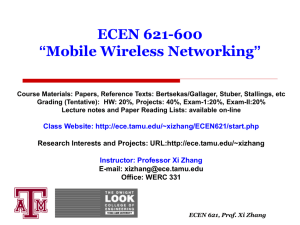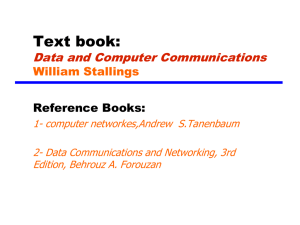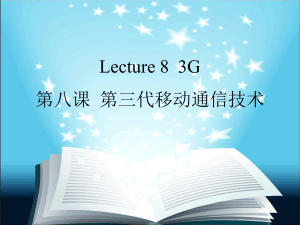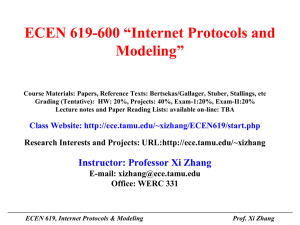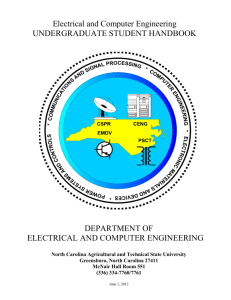Lecturing Notes 4
advertisement
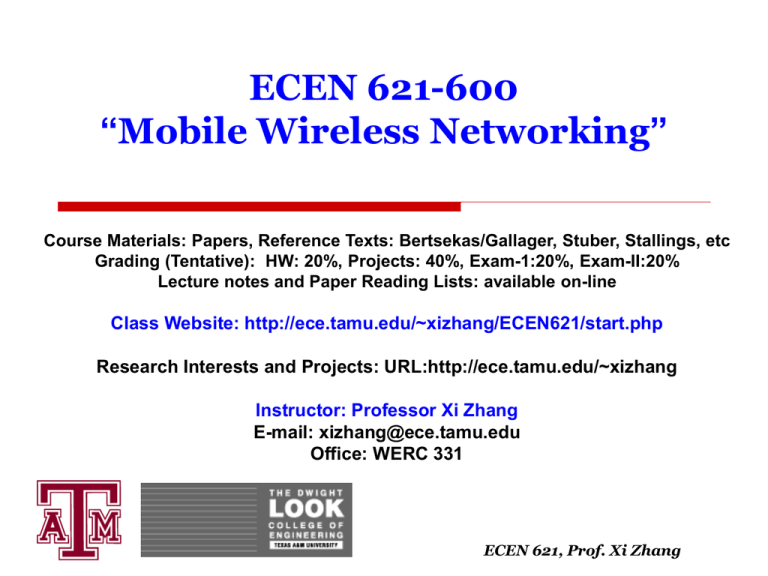
ECEN 621-600 “Mobile Wireless Networking” Course Materials: Papers, Reference Texts: Bertsekas/Gallager, Stuber, Stallings, etc Grading (Tentative): HW: 20%, Projects: 40%, Exam-1:20%, Exam-II:20% Lecture notes and Paper Reading Lists: available on-line Class Website: http://ece.tamu.edu/~xizhang/ECEN621/start.php Research Interests and Projects: URL:http://ece.tamu.edu/~xizhang Instructor: Professor Xi Zhang E-mail: xizhang@ece.tamu.edu Office: WERC 331 ECEN 621, Prof. Xi Zhang The Fundamentals of Communications Networks Lecture notes 4. ECEN 621, Prof. Xi Zhang Types of Communication Networks Traditional Traditional local area network (LAN) Traditional wide area network (WAN) Higher-speed High-speed local area network (LAN) Metropolitan area network (MAN) High-speed wide area network (WAN) ECEN 621, Mobile Wireless Networks Prof. Xi Zhang Speed and Distance of Communications Networks ECEN 621, Mobile Wireless Networks Prof. Xi Zhang Characteristics of WANs Covers large geographical areas Circuits provided by a common carrier Consists of interconnected switching nodes Traditional WANs provide modest capacity 64000 bps common Business subscribers using T-1 service – 1.544 Mbps common Higher-speed WANs use optical fiber and transmission technique known as asynchronous transfer mode (ATM) 10s and 100s of Mbps common ECEN 621, Mobile Wireless Networks Prof. Xi Zhang Characteristics of LANs Like WAN, LAN interconnects a variety of devices and provides a means for information exchange among them Traditional LANs Provide data rates of 1 to 20 Mbps High-speed LANS Provide data rates of 100 Mbps to 1 Gbps ECEN 621, Mobile Wireless Networks Prof. Xi Zhang Differences between LANs and WANs Scope of a LAN is smaller LAN usually owned by organization that owns the attached devices LAN interconnects devices within a single building or cluster of buildings For WANs, most of network assets are not owned by same organization Internal data rate of LAN is much greater ECEN 621, Mobile Wireless Networks Prof. Xi Zhang The Need for MANs Traditional point-to-point and switched network techniques used in WANs are inadequate for growing needs of organizations Need for high capacity and low costs over large area MAN provides: Service to customers in metropolitan areas Required capacity Lower cost and greater efficiency than equivalent service from telephone company ECEN 621, Mobile Wireless Networks Prof. Xi Zhang Switching Terms Switching Nodes: Stations: Intermediate switching device that moves data Not concerned with content of data End devices that wish to communicate Each station is connected to a switching node Communications Network: A collection of switching nodes ECEN 621, Mobile Wireless Networks Prof. Xi Zhang Switched Network ECEN 621, Mobile Wireless Networks Prof. Xi Zhang Observations of Figure 3.3 Some nodes connect only to other nodes (e.g., 5 and 7) Some nodes connect to one or more stations Node-station links usually dedicated point-to-point links Node-node links usually multiplexed links Frequency-division multiplexing (FDM) Time-division multiplexing (TDM) Not a direct link between every node pair ECEN 621, Mobile Wireless Networks Prof. Xi Zhang Techniques Used in Switched Networks Circuit switching Dedicated communications path between two stations E.g., public telephone network Packet switching Message is broken into a series of packets Each node determines next leg of transmission for each packet ECEN 621, Mobile Wireless Networks Prof. Xi Zhang Phases of Circuit Switching Circuit establishment Information Transfer An end to end circuit is established through switching nodes Information transmitted through the network Data may be analog voice, digitized voice, or binary data Circuit disconnect Circuit is terminated Each node deallocates dedicated resources ECEN 621, Mobile Wireless Networks Prof. Xi Zhang Characteristics of Circuit Switching Can be inefficient Channel capacity dedicated for duration of connection Utilization not 100% Delay prior to signal transfer for establishment Once established, network is transparent to users Information transmitted at fixed data rate with only propagation delay ECEN 621, Mobile Wireless Networks Prof. Xi Zhang Components of Public Telecommunications Network Subscribers - devices that attach to the network; mostly telephones Subscriber line - link between subscriber and network Exchanges - switching centers in the network Also called subscriber loop or local loop A switching centers that support subscribers is an end office Trunks - branches between exchanges ECEN 621, Mobile Wireless Networks Prof. Xi Zhang How Packet Switching Works Data is transmitted in blocks, called packets Before sending, the message is broken into a series of packets Typical packet length is 1000 octets (bytes) Packets consists of a portion of data plus a packet header that includes control information At each node en route, packet is received, stored briefly and passed to the next node ECEN 621, Mobile Wireless Networks Prof. Xi Zhang Packet Switching ECEN 621, Mobile Wireless Networks Prof. Xi Zhang Packet Switching ECEN 621, Mobile Wireless Networks Prof. Xi Zhang Packet Switching Advantages Line efficiency is greater Many packets over time can dynamically share the same node to node link Packet-switching networks can carry out data-rate conversion Two stations with different data rates can exchange information Unlike circuit-switching networks that block calls when traffic is heavy, packet-switching still accepts packets, but with increased delivery delay Priorities can be used ECEN 621, Mobile Wireless Networks Prof. Xi Zhang Disadvantages of Packet Switching Each packet switching node introduces a delay Overall packet delay can vary substantially Each packet requires overhead information This is referred to as jitter Caused by differing packet sizes, routes taken and varying delay in the switches Includes destination and sequencing information Reduces communication capacity More processing required at each node ECEN 621, Mobile Wireless Networks Prof. Xi Zhang Packet Switching Networks Datagram Each packet treated independently, without reference to previous packets Each node chooses next node on packet’s path Packets don’t necessarily follow same route and may arrive out of sequence Exit node restores packets to original order Responsibility of exit node or destination to detect loss of packet and how to recover ECEN 621, Mobile Wireless Networks Prof. Xi Zhang Packet Switching Networks – Datagram Advantages: Call setup phase is avoided Because it’s more primitive, it’s more flexible Datagram delivery is more reliable ECEN 621, Mobile Wireless Networks Prof. Xi Zhang Packet Switching Networks – Virtual Circuit Preplanned route established before packets sent All packets between source and destination follow this route Routing decision not required by nodes for each packet Emulates a circuit in a circuit switching network but is not a dedicated path Packets still buffered at each node and queued for output over a line ECEN 621, Mobile Wireless Networks Prof. Xi Zhang Packet Switching Networks – Virtual Circuit Advantages: Packets arrive in original order Packets arrive correctly Packets transmitted more rapidly without routing decisions made at each node ECEN 621, Mobile Wireless Networks Prof. Xi Zhang Effect of Packet Size on Transmission ECEN 621, Mobile Wireless Networks Prof. Xi Zhang Effect of Packet Size on Transmission Breaking up packets decreases transmission time because transmission is allowed to overlap Figure 3.9a Entire message (40 octets) + header information (3 octets) sent at once Transmission time: 129 octet-times Figure 3.9b Message broken into 2 packets (20 octets) + header (3 octets) Transmission time: 92 octet-times ECEN 621, Mobile Wireless Networks Prof. Xi Zhang Effect of Packet Size on Transmission Figure 3.9c Message broken into 5 packets (8 octets) + header (3 octets) Transmission time: 77 octet-times Figure 3.9d Making the packets too small, transmission time starts increases Each packet requires a fixed header; the more packets, the more headers ECEN 621, Mobile Wireless Networks Prof. Xi Zhang
